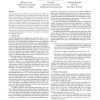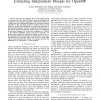1003 search results - page 69 / 201 » How to Parallelize Sequential Processes |
ASPDAC
2009
ACM
14 years 1 months ago
2009
ACM
Iterative retiming and resynthesis is a powerful way to optimize sequential circuits but its massive adoption has been hampered by the hardness of verification. This paper tackle...
PDP
2008
IEEE
14 years 3 months ago
2008
IEEE
This paper addresses the issue of type safe algorithmic skeletons. From a theoretical perspective we contribute by: formally specifying a type system for algorithmic skeletons, an...
DATE
2010
IEEE
14 years 1 months ago
2010
IEEE
—Synchronous languages offer a deterministic model of concurrency at the level of actions. However, essentially all compilers for synchronous languages compile these actions into...
PODC
1995
ACM
14 years 10 days ago
1995
ACM
We show how solution concepts in games such as Nash equilibrium, correlated equilibrium, rationalizability, and sequential equilibrium can be given a uniform definition in terms ...
MM
2005
ACM
14 years 2 months ago
2005
ACM
Graphics and vision are approximate inverses of each other: ordinarily Graphics Processing Units (GPUs) are used to convert “numbers into pictures” (i.e. computer graphics). I...


